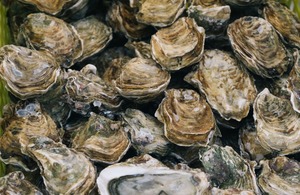Oyster herpesvirus disease outbreak confirmed in Humber Estuary
Oyster herpesvirus (OsHV-1 µvar) disease outbreak confirmed in Alexandra Dock, Port of Grimsby, Humber Estuary

Following a report from the Environment Agency of mortalities in a wild population of Pacific oysters (Magallana [syn. Crassostrea] gigas) at Alexandra Dock in the Port of Grimsby, Humber Estuary, a Fish Health Inspector from the Centre for Environment, Fisheries and Aquaculture Science (Cefas) visited the affected site to inspect the oysters and collect samples for analysis at Cefas National Reference Laboratory for molluscan diseases. Samples taken from the affected population were confirmed as positive for oyster herpesvirus-1 microvariant (OsHV-1 µvar), and a new containment area covering the tidal waters of the Humber Estuary has been declared. More information on oyster herpesvirus-1 microvariant can be found at https://www.gov.uk/government/publications/ostreid-herpesvirus-1-microvariant-oyster-herpesvirus.
In accordance with The Aquatic Animal Health Regulations (England and Wales) 2009, movements of shellfish out of the containment area have been restricted to prevent spread of disease, following the confirmation of oyster herpesvirus-1 microvariant (OsHV-1 µvar).
Cefas acting on behalf of Defra has issued a Confirmed Designation prohibiting the movement of Pacific oysters from the containment area and applied the following additional control measures:
- You must apply to the Fish Health Inspectorate for permission if you wish to move any Pacific oysters out of the Confirmed Designation area, including movements into purification centres (depuration plants).
- You must notify the Fish Health Inspectorate of any increased or unexpected mortality observed in shellfish stocks.
In addition, England continues to have [OsHV-1µVar control areas Controls of fish and shellfish diseases in England and Wales - GOV.UK] in Essex, Kent and Suffolk; Butley Creek; Poole Harbour and the River Teign and River Exe.
There are no implications for human health and no farms producing Pacific oysters in the affected area.
OsHV-1 µvar affects Pacific oysters and can result in high rates of shellfish mortalities. Any suspicion of the presence of OsHV-1µVar in Pacific oysters should be immediately reported to:
Fish Health Inspectorate
Email fhi@cefas.gov.uk Tel 01305 206700
Monday to Thursday: 9am to 5pm, Friday: 9am to 4.30pm
Additional notes
- Cefas is an executive agency of the Department for Environment, Food and Rural Affairs (Defra). The Fish Health Inspectorate (FHI), based at Cefas’ Weymouth laboratory, is dedicated to maintaining and improving fish and shellfish health in England and Wales. Its primary role is to act for Defra and Welsh Government (WG) in undertaking statutory duties resulting from national legislation on fish and shellfish health and the prevention and control of serious diseases. The FHI is responsible for health certification of fish and shellfish movements from other countries and runs an enforcement programme aimed at preventing the illegal importation of these animals.
- Oyster herpesvirus-1 microvariant (OsHV-1 µvar) is a notifiable disease under The Aquatic Animal Health (England and Wales) Regulations 2009. Outbreaks of this disease have been subject to statutory control in GB since 2010.
- CD21.2025_Confirmed_Designation_Accessible_Format_and_Map_20.08.2025.pdf issued under the Aquatic Animal Health, England and Wales Regulations 2009 restricts the movement of live shellfish, into and out of the designated area without the prior written consent of the Fish Health Inspectorate at Cefas and applies additional specific biosecurity measures.